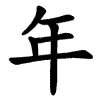年
- year;
- age;
- annual cycle;
Etymology
Oracle bone script (甲骨文 jiǎgǔwén): depicts 禾 (grain) carried by 人 (person) → symbolizing a harvest, thus marking the completion of a yearly cycle.
Bronze inscriptions (金文 jinwen): shows variants with additional dots or strokes within 人.
Seal script (小篆): 人 transformed into 千 with a long horizontal stroke; this led Xu Shen (허신) in 《설문해자》 to misinterpret it as a phono-semantic compound (禾 “grain” + 千 “phonetic”).
True origin: pictographic compound representing “a person carrying grain,” i.e., the harvest cycle that defines a year.
Semantic range:
- year, annual cycle;
- age (years of life);
- by extension: era, time period.
Usage in Korean
연도 (年度) — year, annual term
생년 (生年) — year of birth
학년 (學年) — school year, grade
연령 (年齡) — age
연말 (年末) — year-end
연초 (年初) — beginning of the year
연중 (年中) — throughout the year
신년 (新年) — New Year
Words that derived from 年
- 내년(來年)–next year
- 년(年)–A bound noun that serves as a unit for counting the number of years
- 노년(老年)–old age
- 만년필(萬年筆)–fountain pen
- 성년(成年)–adult age
- 소년(少年)–boy
- 신년(新年)–new year
- 연(年)–year
- 연대(年代)–period; age
- 연령(年齡)–age
- 연말(年末)–end of the year
- 연세(年歲)–age
- 윤년(閏年)–leap year
- 작년(昨年)–last year
- 재작년(再昨年)–the year before last year
- 청년(靑年)–young person; youth
- 청소년(靑少年)–teenager
- 평년(平年)–year of average crop; average temperature; common year
- 흉년(凶年)–lean year; year of poor harvest; bad year; famine
Alternative forms
秊 (U+79CA), which preserves the early seal script form.
- 人手 (OQ)
- ⿱ 𠂉 㐄
- ⿻ 午 ⿱ 一 丨
- ⿻ 午 丄
